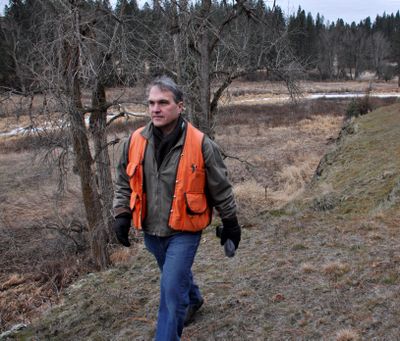Landers: Land Trust hits 15,000 acre milestone

Trust is the operative word in the name of a nonprofit group that’s helping make the region a better place for fish, wildlife and people.
“We work with landowners and sometimes it takes years before they’re ready to make decisions on the future of their property,” said Chris DeForest, executive director for the Inland Northwest Land Trust (inlandnwlandtrust .org).
The nonprofit group, founded in 1991, closed on two agreements last week to hit the milestone of 15,000 acres of private land preserved in conservation easements on 47 properties.
“That 15,000 might sound like a drop in the bucket,” he said, “but it’s a very important drop.”
Five white-tailed deer flashed their namesake flags as if to emphasize his point Wednesday as we approached the latest conservation prize, on Hangman Creek east of Spangle.
The 142 acres signed into a perpetual conservation plan by the Ralph Hein family on Friday joins a 322-acre easement secured in 2008 just downstream from Kentuck Trails Road. Together they assure that 2.5 miles of the creek, pine-shaded basalt cliffs, cottonwood-hawthorn bottoms and some of the most intact native ecosystems on the drainage continue to provide for fish and critters.
This is the Land Trust’s third protected parcel along Latah Creek and fourth within the Latah Creek watershed.
“I like to think of it as conservation sprawl,” DeForest said. “It’s a small way to try and balance the not-so desirable type of sprawl. A conservation easement is a permanent decision, but so is subdivision and development.”
Landowners draw up easements for a range of practical and private reasons: “Some are protecting the land for their kids and some are protecting it from their kids,” he said.
Hein family members discussed the options for 13 years before deciding to protect the land their ancestors had acquired in 1889. If the family ever decides to sell, the land will continue to be protected.
It’s not all in natural condition. The family wants to continue generating income from crops on a portion of the property that’s cultivated, and the contract guarantees they can develop an acre on the property should they ever want to build.
Cropland next to good habitat is a win-win for wildlife, DeForest said: “And providing one acre for potential development is a far cry better than the other alternatives. Under current zoning, this land could be divided into eight parcels.”
These slices of wildlife heaven are essential in maintaining corridors for wildlife that needs to move, such as elk and moose, he said.
The INLT has helped protect small but critical lands that were later taken over by other entities, such as Mirabeau Point Park, now managed by Spokane Valley, and the Reardan Ponds, a prime waterfowl rest stop assumed by the Washington Department of Fish and Wildlife.
Also last week, INLT protected 297 acres and 1.5 miles of shoreline in the Priest River basin in Bonner County. Logging will continue on the land under a plan that assures protection for elk habitat and a tributary important to bull trout.
So far, the group has protected land along 34 miles of river and lake shores in the region, not counting the intermittent streams.
The strategy for the next five years is to focus on land along waterways and lakes.
“This land has the greatest habitat value and also faces the greatest threats,” said DeForest, a trained forester. “We apply science and common sense to where we work.”
In addition to peace of mind, landowners can benefit financially from conservation easements.
Giving up some of the value of their land to a charitable organization offers tax benefits.
“That’s society’s way of thanking the landowner for contributing to clean water and habitat protection,” DeForest said. And estate taxes are lower for conservation land that is no longer open to subdivision.
About 1,800 land trusts are working across the United States, including eight in Idaho and 30 in Washington. The conservation easements they oversee give agencies and other groups the assurance they need to initiate restoration and enhancement projects that won’t be undone by the next landowner.
For example, easements in the Hangman drainage are prompting The Lands Council, Department of Ecology, Trout Unlimited and school groups to invest time and money for conservation efforts.
“Our three objectives are protecting land, caring for land and connecting people with nature,” DeForest said, noting the INLT’s nature walks and specialty outings to educate people about birds, butterflies, dragonflies and other species.
INLT, based at 35 W. Main Ave. in Spokane, has a volunteer board of directors and a staff of five supported by grants and fund-raising efforts plus about 400 members who donate $15-$5,000 a year to the cause.
“There’s an example of a family that ought to support the Land Trust,” DeForest said, pointing to a rural home recently built overlooking the Hein property and Hangman Creek.
“Our conservation easement has protected their view forever.”